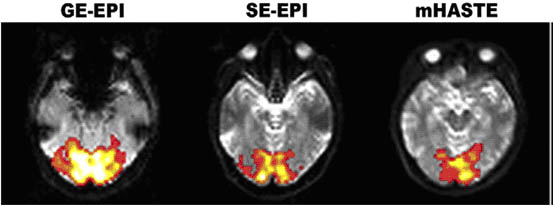An alternative method for BOLD fMRI
In addition to their interest in the relationship between form and motion perception, Professor Yan Zhuo’s research group focuses on developing new methods for functional magnetic resonance imaging (fMRI),a method of neuroimaging that relies on measuring changes in blood flow related to neural activity in the brain. fMRI is widely used in brain mapping due to its relatively low invasiveness and wide availability.
Gradient-echo echo planar imaging (GE-EPI) is the most commonly used technique for BOLD fMRI due to its high sensitivity and efficiency, but it suffers from image distortion and compromised function localization. For more than a decade, turbo spin echo (TSE) pulse sequences have been suggested as an alternative to GE-EPI sequences for fMRI studies, and recent developments in parallel imaging have renewed interest in developing more robust TSE sequences for fMRI.
In their recent Neuroimage article1, Professor Zhuo’s group report the development of a modified half Fourier acquisition single-shot TSE (mHASTE) sequence with a three-fold GRAPPA which improves temporal resolution, and the introduction of preparation time to enhance BOLD sensitivity. Using a classical flashing checkerboard block design, they systematically analyzed the BOLD (blood-oxygen-level dependent) signal characteristics of this novel method as a function of several sequence parameters and compared them with those of gradient-echo and spin-echo EPI sequences. Validation of the method with experimental studies on the visual cortex of five volunteers showed that mHASTE is more sensitive to extra-vascular BOLD effects around microvascular networks, thus enabling more accurate function localization. The activation cluster size in mHASTE increases with the refocusing of the RF flip angle and TE, and decreases with the echo number (ncenter) used to sample the k-space center. Compared to spin-echo EPI, mHASTE incurs an ~50% reduction in activation cluster size and an ~20% decrease in BOLD contrast. However a higher signal-to-noise ratio and a spatially more uniform temporal stability have been observed when using mHASTE compared with EPI sequences when scan times are held constant. Prof Zhuo’s group are currently investigating further refinements and optimizations of mHASTE, and expect that it will become a viable alternative for fMRI in situations where conventional EPI sequences are limited or prohibitive.
This research was conducted in collaboration with colleagues at the University of Illinois Medical Center in Chicago, and was supported by grants from the Chinese Ministry of Science and Technology, the National Natural Science Foundation, the Knowledge Innovation Program of the Chinese Academy of Sciences, the US National Institute of Health, and the University of Illinois Medical Center.
1Yongquan Ye, Yan Zhuo, Rong Xue, & Xiaohong Joe Zhou (2010): BOLD fMRI using a modified HASTE sequence. NeuroImage 49: 457–466. doi:10.1016/j.neuroimage.2009.07.044

Source images with the superimposed activation clusters from one representative subject. The images were acquired using GE-EPI, SE-EPI and mHASTE, respectively. Images and activations are not normalized to the ICBM-defined T1 standard space.

